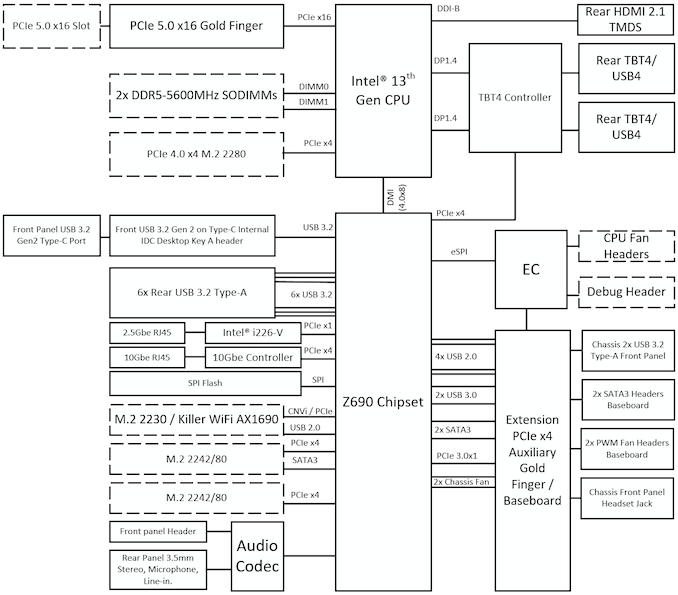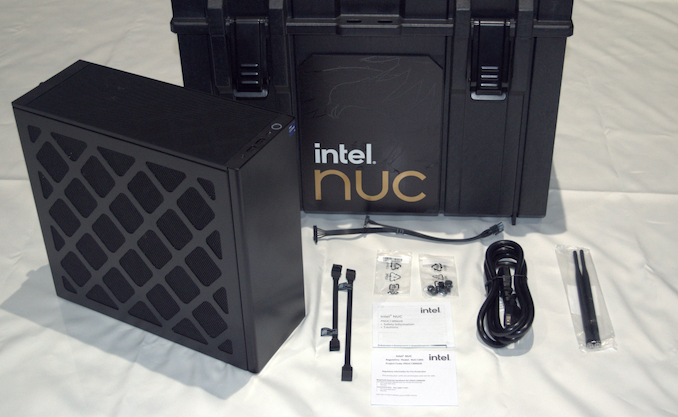Intel Launches Raptor Canyon: Desktop Raptor Lake Sizzles in NUC13 Extreme
by Ganesh T S on November 8, 2022 9:00 AM EST- Posted in
- Systems
- Intel
- NUC
- Raptor Lake
- Raptor Canyon
- NUC13
- NUC Extreme
- Shrike Bay

Intel is officially taking the wraps off the first member of their Raptor Lake-based NUC13 family today. The NUC13 Extreme (like the three previous Extreme NUCs) caters to the gamers and content creators requiring leading edge performance and high-end discrete GPU support. Unlike the mainstream NUCs which have been consistently maintaining an ultra-compact form-factor profile, the Extreme family has slowly grown in size to accommodate flagship CPUs and discrete GPUs. These systems integrate a motherboard in a PCIe add-in card form factor (the Compute Element) and a baseboard that provides additional functionality with PCIe slots and other I/O features. As a refresher, Intel created the NUC Extreme category with the introduction of the Ghost Canyon NUC family in 2019. This was followed by the Tiger Lake-based Beast Canyon NUC in 2021 and the Alder Lake-based Dragon Canyon NUC earlier this year. The latest member of this family is today's introduction - the Raptor Canyon NUC based on the Shrike Bay Compute Element.
The NUC Extreme family has grown in physical footprint with each generation, and the NUC13 Extreme is Intel's biggest one yet. Coming in at 317mm x 129mm x 337mm (13.7L), this is more of a traditional tower desktop than the NUCs that the market has grown accustomed to. However, this size has allowed Intel to integrate flagship components. The Shrike Bay Compute Element supports socketed LGA 1700 processors with a PL1 of 150W and PL2 of 250W (tau of 28s). The vertical centering of the baseboard within the case enables plenty of isolation between the Compute Element on the top and the discrete GPU on the bottom. Triple-slot dGPUs up to 12.5" in length are supported.
The NUC13 Extreme Kit comes in three flavors, while the Shrike Bay Compute Element itself has six variations. These allow system integrators and OEMs to offer a wide variety of systems targeting different market segments. The table below summarizes the key differences between the three NUC13 Extreme kits.
| Intel NUC13 Extreme Kits (Raptor Canyon) | ||||
| Model | NUC13RNGi9 | NUC13RNGi7 | NUC13RNGi5 | |
| CPU | Intel Core i9-13900K Raptor Lake, 8P + 16E / 32T 5.8 GHz (Turbo) / 5.4 GHz (P) / 4.3 GHz (E) 125W TDP (Up to 253W) |
Intel Core i7-13700K Raptor Lake, 8P + 8E / 24T 5.4 GHz (Turbo) / 5.3 GHz (P) / 4.2 GHz (E) 125W TDP (Up to 253W) |
Intel Core i5-13600K Raptor Lake, 6P + 8E / 20T 5.1 GHz (Turbo) / 5.1 GHz (P) / 3.9 GHz (E) 125W TDP (Up to 181W) |
|
| GPU | Intel UHD Graphics 770 (300 MHz - 1.65 GHz) | Intel UHD Graphics 770 (300 MHz - 1.60 GHz) | Intel UHD Graphics 770 (300 MHz - 1.50 GHz) | |
| Memory | 2x DDR5-5600 SODIMMs (up to 64GB) |
|||
| Motherboard (Compute Element) | 295.3mm x 136.5mm x 46.1mm (Custom) | |||
| Storage | 1x CPU-attached PCIe 4.0 x4 M.2 2280 1x PCH-attached PCIe 4.0 x4 M.2 2242 / 2280 1x PCH-attached PCIe 4.0 x4 / SATA M.2 2242 / 2280 2x SATA 6 Gbps (on baseboard) |
|||
| I/O Ports | 2x USB4 / Thunderbolt 4 (Type-C) (Rear) 6x USB 3.2 Gen 2 Type-A (Rear) 1x USB 3.2 Gen 2 Type-C (Front) 2x USB 3.2 Gen 1 Type-A (Front) |
|||
| Networking | Intel Killer Wi-Fi 6E AX1690i (2x2 802.11ax Wi-Fi inc. 6 GHz + Bluetooth 5.2 module) 1× 2.5 GbE port (Intel I226-V) 1x 10 GbE port (Marvell AQtion AQC113C) |
|||
| Display Outputs | 2x DP 2.0 (1.4 certified) (via Thunderbolt 4 Type-C, iGPU) 1x HDMI 2.1 (up to 4Kp60) (rear, iGPU) |
|||
| Audio / Codec | 7.1 digital (over HDMI and Thunderbolt 4) Realtek ALC1220 Analog Audio / Microphone / Speaker / Line-In 3.5mm (Rear) USB Audio 3.5mm combo audio jack (Front) |
|||
| Enclosure | Metal Kensington lock with base security |
|||
| Power Supply | FSP750-27SCB 750W Internal PSU | |||
| Dimensions | 337mm x 317mm x 129mm / 13.7L | |||
| Chassis Expansion | One PCIe 5.0 x16 with triple-slot GPU support up to 317.5mm in length | |||
| Customizable RGB LED illumination on chassis underside CEC support for HDMI port Power LED ring in front panel 3-year warranty |
||||
Each kit SKU corresponds to a NUC13SBB Shrike Bay Compute Element. In addition, Intel is also readying the NUC13SBBi(9/7/5)F variants that come with the KF processors - those Compute Elements do not have any Thunderbolt 4 ports. The HDMI port / graphics outputs are also not present. The three KF SKUs also forsake the 10GbE port.
The block diagram below gives some insights into the design of the system in relation to the I/O capabilities. Note that the system continues to use the Z690 chipset that was seen in the Dragon Canyon NUC.
PCIe x16 bifurcation (x8 + x8) is possible for the Gen 5 lanes. However, the baseboard design in the Raptor Canyon NUC kits does not support it. This is yet another aspect that OEMs could use to differentiate their Shrike Bay-based systems from the NUC13 Extreme.
Intel has provided us with a pre-production engineering sample of the flagship Raptor Canyon NUC (augmented with an ASUS TUF Gaming RTX 3080Ti GPU) for review, and it is currently being put through the paces. The 150W PL1 and microarchitectural advances in Raptor Lake have ensured that the benchmark scores are off the charts compared to the previous NUC Extreme models, albeit at the cost of significantly higher power consumption. On the industrial design side, I have been very impressed. By eschewing a fancy chassis and opting for a simple cuboid, Intel has ensured that all the I/O ports are easily accessible, installation of components is fairly straightforward, and cable management is hugely simplified. The increased dimensions of the chassis are well worth these advantages over the previous NUC Extreme models. Stay tuned for a comprehensive review later this week.












27 Comments
View All Comments
nandnandnand - Tuesday, November 8, 2022 - link
Introducing the Next Unit of Computing: Extended ATX.powerarmour - Tuesday, November 8, 2022 - link
NUC has become it's own meme now, these size increases are just laughable.cbutters - Tuesday, November 8, 2022 - link
the "Next Unit of Computing" a regular sff case that takes a regular GPU... Maybe they should have rebranded for this a little? (I tease)edzieba - Tuesday, November 8, 2022 - link
You'd be hard pressed to build a SFF PC of similar specs, with an INTERNAL PSU, in 13.7L. Comparable SFF sizes will be using an external AC-DV brick and an internal DC-DC (usually 48v-ATX or 19V-ATX) converter in order to achieve a similar form factor, and will be coming in well below the 750W rating here.meacupla - Tuesday, November 8, 2022 - link
Not true at all. 13.7L is getting into compact mATX territory.Kaibou ZZaw C2: mATX, 4 slot, 14L
Lian-Li Q58: mITX, 3 slot, 14.5L
Sliger S610: mITX, 3 slot, 13.3L
Dan cases C4-SFX: mITX, 3.5 slot, 13.37L
Louqe Raw S1: mITX, 3 slot, 12L
SFX PSUs with 750W are easy to find. There are even SFX-L 1000W from Lian-Li, and 1200W from Asus.
Thunderbolt4 for mATX/mITX can be had on:
Asus ROG Strix Z690-I Gaming Wifi
Asrock Z690 Phantom gaming ITX/TB4
and their Z790 versions
These TB4 mobos are very expensive, but it still ends up beating Intel's NUC13 extreme for price.
In fact, I would say that this NUC13 with 13.7L size is a huge disappointment, considering it uses a full custom mobo, and uses air cooling.
dwillmore - Tuesday, November 8, 2022 - link
It really looks like the NUC project has ended. This is just a normal SFF PC.I'd also like to mention that it "caters to the gamers and content creators requiring leading edge performance and high-end discrete GPU support." How does it do that? By having a tripple width PCI-E slot? Certainly not by having a useful IGP for those tasks. By having a very hot CPU in a tiny box? How is that helping gamers or content creators? I could stuff a normal PC into a 19" A/V component case and have a better arguement for supporting gamers and content creators.
PeachNCream - Tuesday, November 8, 2022 - link
All perfectly valid questions you're asking. I would add that "gamers and content creators" are two meaningless classifications of people in general. Its market speak that staggering corporate zombies use to vaguely follow dumb labels that spring up around people that are playing video games (duh, that's everyone) or are streaming their games in the desperate hopes of becoming one of the 0.0001% of people that earn a little bit of income doing it. Meanwhile we all can smell the stink on the terminology which has been overused for a few years already.mukiex - Wednesday, December 14, 2022 - link
This is a normal SFF PC that's priced like a laptop. $2000 with 8GB of RAM and another $1189 for an RTX 3080. Literally 4080 pricing for a card you can find online for under $800.cyrusfox - Tuesday, November 8, 2022 - link
Looking forward to the review as well as more pictures.The design seems a bit more chonky (Blame the need to house 3 slot GPU). Would be sweet if someone could create a custom loop water to eliminate that GPU surface area cooling required, some sort of integrated radiator in case to bring the size back down.
flgt - Tuesday, November 8, 2022 - link
I actually really like this design if the power supply is integrated and you can fit a decent mid-tier discrete GPU in it. It slots in between SFF and tower, but other SFF only have half height PCIe slots. Industrial design is better than previous generations. Hopefully price isn’t too outrageous.Not sure why people are saying NUC is dead. Standard NUC’s will be arriving soon enough. Offering unique designs and having more options at different form factors, performance, and price points is good for the customers.